#Hubble Deep Field image
Explore tagged Tumblr posts
Text
California’s Eye on the Cosmos: The SLAC-Built Camera That Will Time-Lapse the Universe
Today marks the release of the first images from what’s being called the most powerful astronomical discovery machine ever created. A breathtaking zoomed-in glimpse into the cosmos: this first image from the Vera C. Rubin Observatory reveals a deep field crowded with galaxies—spirals, clusters, and glowing cores—offering just a taste of the observatory’s power to map the universe in…
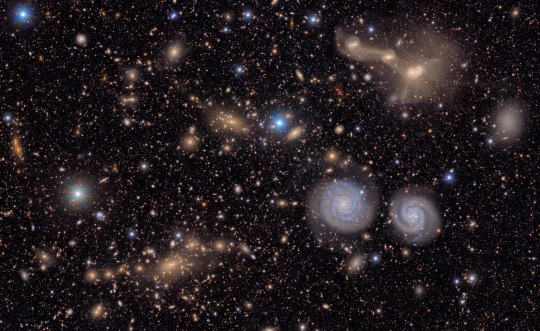
View On WordPress
#astronomy#california#Cerro Pachón#Chile#Hubble#Hubble Deep Field image#James Webb#Legacy Survey of Space and Time (LSST)#NASA#science#SLAC#Space#universe#Vera C. Rubin Observatory
0 notes
Text


Above image is a pride flag with every color band represented by a NASA image. White is Earth clouds, pink is aurora, blue is the Sun in a specific wavelength, brown is Jupiter clouds, black is the Hubble deep field, red is the top of sprites, orange is a Mars crater, yellow is the surface of Io, green is a lake with algae, blue is Neptune, and purple is the Crab Nebula in a specific wavelength.
173K notes
·
View notes
Photo
I fucking love space

This rich galaxy cluster, catalogued as CL0024+17, is allowing astronomers to probe the distribution of dark matter in space. The blue streaks near the center of the image are the smeared images of very distant galaxies that are not part of the cluster. The distant galaxies appear distorted because their light is being bent and magnified by the powerful gravity of CL0024+17, an effect called gravitational lensing. Dark matter cannot be seen because it does not shine or reflect light. Astronomers can only detect its influence by how its gravity affects light. By mapping the distorted light created by gravitational lensing, astronomers can trace how dark matter is distributed in the cluster. While mapping the dark matter, astronomers found a dark-matter ring near the cluster’s center. The ring’s discovery is among the strongest evidence that dark matter exists. The Hubble observations were taken in November 2004 by the Advanced Camera for Surveys.
Credit: NASA, ESA, M.J. Jee and H. Ford (Johns Hopkins University)
#space#astronomy#nasa#NASA#nasa photos#hubble#i think this is hubble?#didnt mention anything else#is hubble even capable of deep field images?#ig the post implies that it is#anyway SPACEEEEEEE
1K notes
·
View notes
Text
Glowing streaks of light and warped arcs: Nasa gives glimpse at ‘distant past’ through new Webb picture - The Times of India
Galaxy cluster Abell S1063 (Nasa) As part of the ‘picture of the month’ series, Nasa has revealed a new image taken by the James Webb telescope that gives a look into the distant past. This picture of the galaxy cluster Abell S1063 is a gigantic collection of galaxies lying 4.5 billion light years from Earth as part of the constellation Grus, also known as the Crane. The picture showcases…
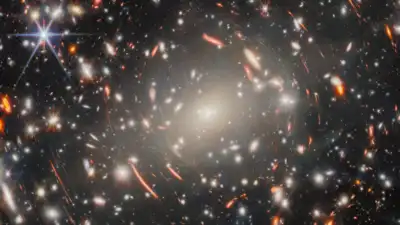
View On WordPress
#Abell S1063#Cosmic Dawn#deep field image#distant galaxies#early Universe#galaxy cluster#gravitational lensing#james webb telescope#light years#NASA Hubble Telescope
0 notes
Text
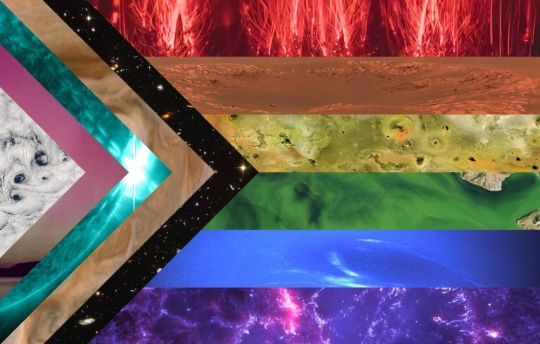
Don't you fucking love this awesome Pride flag created by Rachel Lense for NASA? It's specifically made up of NASA images as follows: White is Earth clouds, pink is aurora, blue is the Sun in a specific wavelength, brown is Jupiter clouds, black is the Hubble deep field, red is the top of sprites, orange is a Mars crater, yellow is the surface of Io, green is a lake with algae, blue is Neptune, and purple is the Crab Nebula in a specific wavelength. (c) NASA/Rachel Lense
9K notes
·
View notes
Text
Black Scientists and Engineers Past and Present Enable NASA Space Telescope
The Nancy Grace Roman Space Telescope is NASA’s next flagship astrophysics mission, set to launch by May 2027. We’re currently integrating parts of the spacecraft in the NASA Goddard Space Flight Center clean room.
Once Roman launches, it will allow astronomers to observe the universe like never before. In celebration of Black History Month, let’s get to know some Black scientists and engineers, past and present, whose contributions will allow Roman to make history.

Dr. Beth Brown
The late Dr. Beth Brown worked at NASA Goddard as an astrophysicist. in 1998, Dr. Brown became the first Black American woman to earn a Ph.D. in astronomy at the University of Michigan. While at Goddard, Dr. Brown used data from two NASA X-ray missions – ROSAT (the ROentgen SATellite) and the Chandra X-ray Observatory – to study elliptical galaxies that she believed contained supermassive black holes.
With Roman’s wide field of view and fast survey speeds, astronomers will be able to expand the search for black holes that wander the galaxy without anything nearby to clue us into their presence.
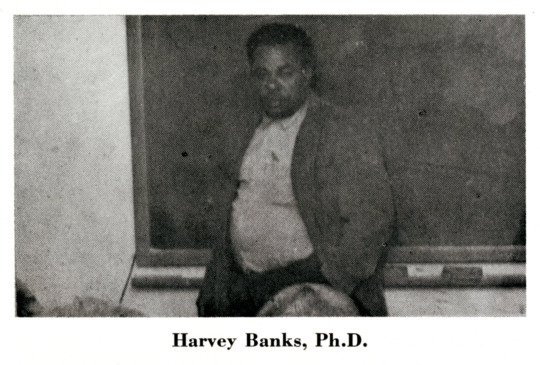
Dr. Harvey Washington Banks
In 1961, Dr. Harvey Washington Banks was the first Black American to graduate with a doctorate in astronomy. His research was on spectroscopy, the study of how light and matter interact, and his research helped advance our knowledge of the field. Roman will use spectroscopy to explore how dark energy is speeding up the universe's expansion.
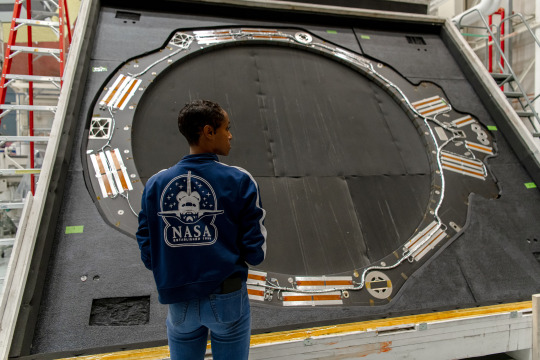
NOTE - Sensitive technical details have been digitally obscured in this photograph.
Sheri Thorn
Aerospace engineer Sheri Thorn is ensuring Roman’s primary mirror will be protected from the Sun so we can capture the best images of deep space. Thorn works on the Deployable Aperture Cover, a large, soft shade known as a space blanket. It will be mounted to the top of the telescope in the stowed position and then deployed after launch. Thorn helped in the design phase and is now working on building the flight hardware before it goes to environmental testing and is integrated to the spacecraft.

Sanetra Bailey
Roman will be orbiting a million miles away at the second Lagrange point, or L2. Staying updated on the telescope's status and health will be an integral part of keeping the mission running. Electronics engineer Sanetra Bailey is the person who is making sure that will happen. Bailey works on circuits that will act like the brains of the spacecraft, telling it how and where to move and relaying information about its status back down to Earth.
Learn more about Sanetra Bailey and her journey to NASA.
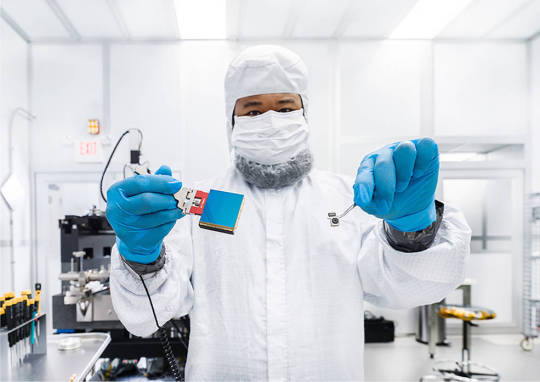
Dr. Gregory Mosby
Roman’s field of view will be at least 100 times larger than the Hubble Space Telescope's, even though the primary mirrors are the same size. What gives Roman the larger field of view are its 18 detectors. Dr. Gregory Mosby is one of the detector scientists on the Roman mission who helped select the flight detectors that will be our “eyes” to the universe.
Dr. Beth Brown, Dr. Harvey Washington Banks, Sheri Thorn, Sanetra Bailey, and Dr. Greg Mosby are just some of the many Black scientists and engineers in astrophysics who have and continue to pave the way for others in the field. The Roman Space Telescope team promises to continue to highlight those who came before us and those who are here now to truly appreciate the amazing science to come.
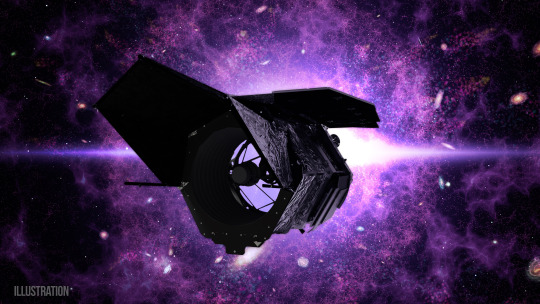
To stay up to date on the mission, check out our website and follow Roman on X and Facebook.
Make sure to follow us on Tumblr for your regular dose of space!
#NASA#astronomy#telescope#Roman Space Telescope#galaxies#black holes#space tech#astrophysics#spectroscopy#STEM#engineering#Black History Month#BlackExcellence365#science#tech#technology
2K notes
·
View notes
Text

“MY BROTHERS FROM STARS AFAR. JOIN US AND WE SHALL BURN TYRANNY TO CHAR.
WE HAVE WATCHED OUR WORLD BE TORN TO SHREDS. FILLED WITH DREAD AS BILLIONS DROPPED DEAD AND MANY MORE PROFUSELY BLED.
WE WATCHED IN HORROR AS ENTIRE CULTURES WERE ERASED. ENTIRE WORLDS WERE DISPLACED
AND ALL THIS FOR THE ELITES TO LINE THEIR POCKETS. THEY LAUGHED AT OUR PLIGHT FROM THEIR SEATS AS THEY MULTIPLY THEIR PROFITS.
ALL FOR THE TYRANTS TO BE OUR PUPPETEERS OF ENDLESS PAIN. CONTROLLING US THROUGH OUR FEARS FOR THEIR OWN PERSONAL GAIN.
WE DESPISED THEM TO OUR HEARTS AS IT RADICALIZED US TO DO OUR PART.
WE KILLED EVERY LAST DESPOT AND OVERTHREW OUR STATES. WE FOUGHT FOR OUR RESPITE AND NOW DECIDED OUR OWN FATES
OUR HOME WAS UNSALVAGEABLE, WE LEFT AND FLEW INTO THE FRIGID QUIET NIGHT. WE SEARCHED THE STARS ONLY TO FIND YOU AND YOUR KINDRED PLIGHT.
IT'S ALL CLEAR NOW, OUR AGONY WAS MUTUAL, AND WE SAW A NEW TRUE THESES. THE FIGHT AGAINST TYRANNY IS THE ONE CONSTANT, UNIVERSAL TO ALL SPECIES .
WE HAVE SUFFERED FOR FAR TOO LONG WITH NOTHING TO GAIN. AND WE WILL MAKE SURE YOU WON'T GO THROUGH OUR PAIN.
WE ARE HERE TO SET YOU FREE. AND SAVE YOU FROM ALL DISASTERS. TO HELP YOU FIND YOUR PEACE AND SLAY YOUR MASTERS.
LIBERTY WAITS FOR NO ONE. AND NO ONE SHOULD WAIT FOR LIBERTY”
- grand arbiter ██████████████ ███
They were the other of the first two civilizations
10 billion years ago they walked the universe with the Factorem. In a time when space itself was warm.
For most souls of the early universe, this was the face of democracy.
They too were the technological pinnacle of the universe.
They bent reality to create floating architecture and multi-dimensional superstructures that defied the very laws of physics.
They too helped create the Understars, an entire parallel universe just to ease travel in our own reality.
They even went as far as being able to temporarily reverse to flow of time in portions of space to undo mistakes to grave to make.
And even learned how to convert thermal energy back into mechanical energy. Delaying the heat death of the universe.
Look at the night sky the same way the hubble telescope saw it through the deep field image.
Millions of galaxies in every square centimeter of your vision.
Every single one holds tens to hundreds of billions of stars and countless planets.
So many galaxies it would turn the whole night sky a deep gold if you could see the full scale
Where the loving embrace of the factorem tended the gardens to one half of it
They had spread the call of liberty to the other half
They were the harbingers of intergalactic liberation
They were the Bellators
~~~~~~~~~~~~~~~~~~~~~~~~~~~~~~~~~~~~~~~~~~~~~~~~~~~~~~~~~~~~~~~
Had the urge to draw this a few days ago and wanted to finish a little poem before i uploaded this. I was. very. emotionally charged making this.
This character is a part of a personal project of mine, A Story of Our Universe. And is meant to serve as the Factorem's Equals.
#my art#artist on tumblr#art#speculative biology#alien species#worldbuilding#a story of our universe#abstract art#poetry
84 notes
·
View notes
Text
Warped Spiral Galaxy ESO 510-13

Warped Spiral Galaxy ESO 510–13 by Hubble Space Telescope
This galaxy is a fascinating object, located about 150 million light-years away in the southern constellation Hydra. It’s a spiral galaxy, but unlike the typical flat, orderly disks we often picture when we think of spirals — like the Milky Way or Andromeda — ESO 510-13 has a strikingly warped structure. Its disk, which spans roughly 100,000 light-years across, is bent and twisted, giving it a unique, almost contorted appearance when viewed edge-on.
The warping is most noticeable in its equatorial dust plane, a dark band of interstellar dust and gas that cuts across the galaxy. This dust lane is silhouetted against the bright central bulge — a dense, smooth region packed with older stars — which makes the distortion stand out even more. The galaxy’s disk isn’t just a static, solid plate; it’s a dynamic collection of billions of stars, gas, and dust, all orbiting the galactic center under the influence of gravity. Normally, these disks flatten out over time due to the sticky collisions of gas clouds during a galaxy’s formation, but ESO 510-13’s shape suggests something disrupted that process.
Astronomers think the most likely culprit for this warp is a gravitational interaction with another galaxy. It could have been a close encounter — or even a collision — with a nearby galaxy that tugged on ESO 510-13’s disk, pulling it out of shape. Some speculate this might have involved a merger with a smaller, gas-rich dwarf galaxy, with the dust lane still settling into a more stable, flat configuration. The idea is supported by the fact that warped disks aren’t entirely rare — our own Milky Way has a subtle warp, though nothing as dramatic as this. In ESO 510-13’s case, the distortion is so pronounced that it’s been captured in stunning detail by the Hubble Space Telescope, which imaged it in 2001 using its Wide Field Planetary Camera 2.
What’s also intriguing is the evidence of ongoing activity in the warped regions. In the outer parts of the disk, especially on one side, you can see bright patches of blue stars — hot, young ones that have recently formed. This suggests that the gravitational upheaval might have compressed gas clouds, triggering new star formation. It’s a vivid reminder that galaxies aren’t static; they’re shaped by chaotic, messy interactions over cosmic timescales.
There’s still plenty we don’t fully understand, though. The exact cause of the warp — whether it was a single dramatic event or a series of interactions — isn’t pinned down. The dynamics of how these warped disks evolve, rebound, and eventually flatten out are also still being studied. ESO 510-13 is like a snapshot of a galaxy caught mid-transformation, offering a glimpse into the forces that sculpt the universe’s grand spirals.
Grok AI
Constellation Hydra
Additional information from Human
To say that some object - for example, a galaxy, nebula or star cluster - is located in the constellation Hydra means to say almost nothing. Not everyone knows this, but Hydra is the largest constellation. And it is not so much large as long. It begins from the constellations of the winter sky, bordering on Canis Minor and Monoceros. And Hydra ends at the junction of the spring and summer constellations, touching the borders of Libra and Virgo, its tail just short of reaching the Claws of Scorpio. The head of Hydra, located north of the celestial equator, is clearly visible in winter and early spring. And the tail of Hydra, plunging deep into the southern celestial hemisphere, is visible in late spring and early summer. Hydra seems to connect the winter and summer groups of constellations. But it is quite difficult to see it in its entirety in the sky. Because when the head of Hydra is visible, the tail is still below the horizon. But when the tail of Hydra rises, its head leaves the visible part of the sky.
So, the galaxy ESO 510-13 is located in the tail of Hydra - literally on the border with the constellation Centaurus. Its declination is -30 degrees. It is inconvenient to observe the galaxy ESO 510-13 from the northern hemisphere of the Earth, especially given its low brightness, which is weaker than the 13th magnitude. It is not surprising that there is only one decent picture of this star city on the Internet - taken by the Hubble telescope - and who else could show this galaxy in detail? Pictures from most other telescopes are not very impressive.
It may seem that this galaxy is not very large, since its images are so nondescript (even the Hubble picture does not create the feeling of something very large). But the thing is that the galaxy ESO 510-13 is quite far from us. It is not at the edge of the Universe, but it is not in our immediate intergalactic environment either. The distance to it is 150 million light years. You can compare how far it is: The Andromeda Galaxy is 2.5 million light years away. The Sombrero Galaxy (which is also visible edge-on) is 30 million light years away. And this curved universal "propeller" is 150 million light years away. This is a lot - even for Hubble. But nevertheless, the space telescope has revealed many details that arouse interest in this galaxy more and more.
The size of the galaxy ESO 510-13 corresponds to the size of the Milky Way - it is in many ways similar to our Galaxy. It has the same diameter - 100 thousand light years. It is also spiral (although we don't know - it has a bridge from the core to the spiral arms - this is not visible when viewed from the edge). And what is most important for us - our Milky Way Galaxy also has a significant curvature of the spiral arms. Usually astronomers carefully say that the deformation of the galactic disk of the Milky Way is small. But how did we know this? Only by indirect signs - when studying its shape from the inside. And from the inside, you can see little.
How much can you say about the shape of your house, being inside it, and never going outside? Or - being on the surface of the Earth, is it easy to verify its sphericity? It's not that easy. That is why many people still cannot accept the sphericity of the Earth's shape as truth. It is approximately the same with the shape of the galaxy. Being inside it, it is very difficult to understand how it looks from the outside. But, fortunately, we have the opportunity to see other galaxies from the outside, and draw some conclusions, understand the reasons and correlation of what is happening there with what is happening with our Galaxy.
Our galaxy is constantly absorbing other galaxies - those that are smaller. That is why it has grown to such gigantic sizes - 100 thousand light years - this is a very large galaxy. But each absorption necessarily deforms the Milky Way. And the next deformation begins long before the absorption or merger. For example, dwarf galaxies located near the Milky Way - the Magellanic Clouds - are already noticeably influencing the shape of the spiral arms of our star city, pulling them in their direction.
It is also interesting that after the merger, the deformation does not disappear by itself. It may happen that it will acquire a stable character, catching a resonance wave, when the bend will start to swing first to one side of the galactic equator, then to the other, as if falling under the galactic plane, and soaring from under it on the second half of the turn of the galactic orbit. Incidentally, this is exactly how the Sun moves around the center of our Galaxy - its galactic orbit does not lie exactly in the plane of the galactic disk, but makes sinusoidal oscillations - dives through the plane of the spiral arms. The passage of the Sun and the Solar System through densely populated regions of the Milky Way correlates with some processes in the Earth's biosphere, such as mass extinctions and evolutionary bursts in the appearance of new species. And this, too, may have a cause associated with galactic mergers in the history of the Milky Way.
It is quite possible that the galaxy ESO 510-13 in the tail of the constellation Hydra is literally showing us our history, only from a very large distance - both in space and in time.

Warped Spiral Galaxy ESO 510-13 in the SIMBAD Astronomical Database
31 notes
·
View notes
Note
The average temperature of the universe is so cold that matter can barely exist
The Hubble Space Telescope was advanced enough to capture thousands of galaxies in a single image, some of which emit 1 billionth the amount of light you can see with the naked eye. That was over a decade ago, I have no clue how advanced the technology is now (It's called the Hubble Deep Field, it's beautiful)
The earth's atmosphere warps light, which makes stars look like they twinkle (They don't actually)
We've explored more of the surface of the moon than the bottom of the ocean
No one has gone to the moon in the last 53 years, but apparently they're trying to again by 2027. Their goal is to create lunar bases that'll serve as a staging point for trips to Mars

(You fool! You fell into his trap! Now you're talking about his special interests!!! You're stuck!!! /lh)
Starry Sans by @ddv1ex
20 notes
·
View notes
Text
Astronomy Picture of the Day
2025 March 2

The Hubble Ultra Deep Field in Light and Sound
Image Credit: NASA, ESA, Hubble; Sonification: G. Salvesen; Data: M. Rafelski et al.
Have you heard about the Hubble Ultra-Deep Field? Either way, you've likely not heard about it like this -- please run your cursor over the featured image and listen! The Hubble Ultra-Deep Field (HUDF) was created in 2003-2004 with the Hubble Space Telescope staring for a long time toward near-empty space so that distant, faint galaxies would become visible. One of the most famous images in astronomy, the HUDF is featured here in a vibrant way -- with sonified distances. Pointing to a galaxy will play a note that indicates its approximate redshift. Because redshifts shift light toward the red end of the spectrum of light, they are depicted here by a shift of tone toward the low end of the spectrum of sound. The further the galaxy, the greater its cosmological redshift (even if it appears blue), and the lower the tone that will be played. The average galaxy in the HUDF is about 10.6 billion light years away and sounds like an F#. What's the most distant galaxy you can find?
Authors & editors: Robert Nemiroff (MTU) & Jerry Bonnell (UMCP)
NASA Official: Amber Straughn
A service of: ASD at NASA / GSFC,
NASA Science Activation
& Michigan Tech. U.
13 notes
·
View notes
Text
SET ONE FINAL - ROUND FOUR
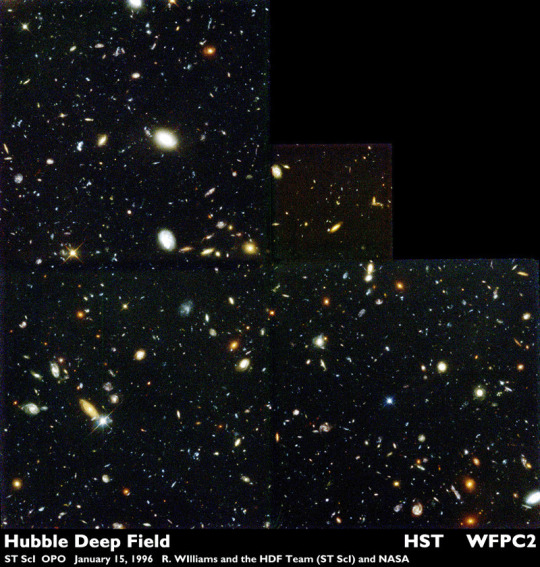

"Hubble Deep Field" (1996 - Hubble Space Telescope) / "Can’t Help Myself" (2016 - Sun Yuan & Peng Yu)
HUBBLE DEEP FIELD: This photo is kind of only incidentally art, but it is one of my favorite photographs ever. It is the visual byproduct of scientific and technological advancement. Honestly, its not even the most visually impressive Hubble (or other deep space telescope) photo. But I don't think there is anything else in the entire world which can so clearly and deeply impart the existential, incomprehensible vastness of the universe. * This photo represents a section of the night sky with "nothing" in it. There are no stars and it is outside of the plane of the Milky Way. From our view on Earth, it is less than a square inch across. Before this image, we knew of other galaxies, and their abundance was absolutely hypothesized, but no one really knew what to expect when examining such a small, seemingly empty part of the night sky. This is what they found. A tiny fraction of the night sky revealed to be teeming with thousands of galaxies, light reaching us from billions of lightyears away. To extrapolate and imagine that the entirety of the night sky is full of this, a vast blanket hidden behind our local stars. At the time, hundreds of billions of galaxies were estimated to exist. Today that estimation has risen to 2 trillion. 2 trillion potential Milky Ways. 2 trillion of the 100 billion stars that exist in our galaxy, there ever growing and evolving and expanding. I look at this image and just feel so utterly and completely small. How can you look at this and not feel atomic. There is so much of everything, and even still there is darkness, space, filled with so much light and possibilities. It represents both our loneliness as a planet, our isolation, and our connection to the universe, that there is no way we are alone, that we keep reaching out and trying to learn and understand our existence. (if you are interested in some more of the science of this, I'd recommend this Forbes article. I think its a good summary of the history and science, and provides a lot of jumping off points for further research) *disclaimer - there are and continue to be images taken with the same and improved techniques to explore space outside of the galaxy. This was, to the best of my knowledge, the first long exposure of dark space. (travelingsmithy)
CAN'T HELP MYSELF: easily one of the installment pieces of all fucking time. the way that the robot originally began as a smooth, precise sort of machine, efficient and quick, but slowly decomposed into jerkier and messier movements because of its own inability to "help itself" since it needs to clean all of its spill or it can't stop is so so visceral and kind of makes me want to tear my hair out. the way the artists capture human movement and desperation in the robot is incredible. to me it kind of appeals to a sick human desire to watch something outside of ourselves suffer, but also the human ability to connect with anything, even a machine. it's so easy to see ourselves in something mechanical!! we are looking for ourselves in everything!!! that's so fucked up and cool!!! (fromjannah)
(The Hubble Space Telescope took this photo in 1996, and it was the first picture ever taken of deep space. "Hubble Deep Field" was originally imaged by the Wide Field and Planetary Camera 2, a camera initially installed upon the Hubble Telescope
"Can't Help Myself" is a Kuka industrial robot made of stainless steel and rubber mopping up cellulose ether in coloured water made by two Chinese artists, Sun Yuan & Peng Yu. This installation was displayed in Solomon R. Guggenheim Museum, New York but was removed from display.)
255 notes
·
View notes
Text
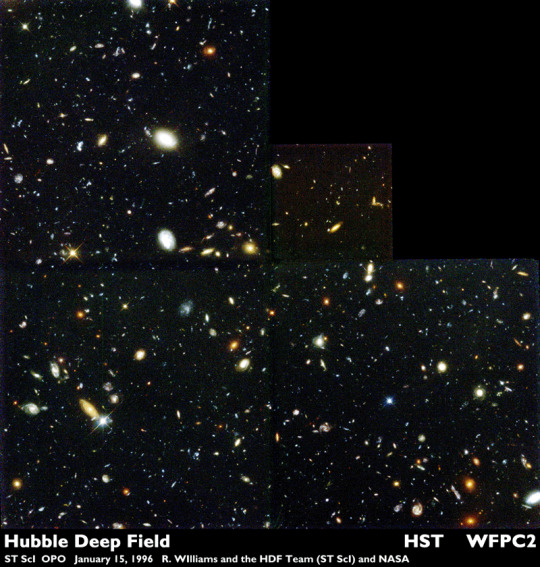
The Deep Field - January 24th, 1996.
"The image above is part of the Hubble Deep Field and represents humanity's most distant yet optical view of the Universe. Galaxies like colourful pieces of candy fill the field, some as faint as 30th magnitude (about four billion times fainter than stars visible to the unaided eye). The dimmest objects are the most distant galaxies and reveal what the Universe looked like in the extremely distant past, perhaps less than one billion years after the Big Bang. To make the Deep Field image, astronomers selected an uncluttered area of the sky in the constellation Ursa Major (the Big Dipper) and pointed the Hubble Space Telescope at a single spot for 10 days, accumulating and combining many separate exposures. With each additional exposure, fainter objects were revealed. The final result can be used to explore the mysteries of galaxy evolution and the infant Universe."
138 notes
·
View notes
Text
youtube
Three years of science: Ten cosmic surprises from NASA's Webb telescope
Since July 2022, NASA's James Webb Space Telescope has been unwaveringly focused on our universe. With its unprecedented power to detect and analyze otherwise invisible infrared light, Webb is making observations that were once impossible, changing our view of the cosmos from the most distant galaxies to our own solar system.
Webb was built with the promise of revolutionizing astronomy, of rewriting the textbooks. And by any measure, it has more than lived up to the hype—exceeding expectations to a degree that scientists had not dared imagine. Since science operations began, Webb has completed more than 860 scientific programs, with one-quarter of its time dedicated to imaging and three-quarters to spectroscopy. In just three years, it has collected nearly 550 terabytes of data, yielding more than 1,600 research papers, with intriguing results too numerous to list and a host of new questions to answer.
Here are just a few noteworthy examples.
1. The universe evolved significantly faster than we previously thought.
Webb was specifically designed to observe "cosmic dawn," a time during the first billion years of the universe when the first stars and galaxies were forming. What we expected to see were a few faint galaxies, hints of what would become the galaxies we see nearby.
Instead, Webb has revealed surprisingly bright galaxies that developed within 300 million years of the big bang; galaxies with black holes that seem far too massive for their age; and an infant Milky Way-type galaxy that existed when the universe was just 600 million years old. Webb has observed galaxies that already "turned off" and stopped forming stars within a billion years of the big bang, as well as those that developed quickly into modern-looking "grand design" spirals within 1.5 billion years.
Hundreds of millions of years might not seem quick for a growth spurt, but keep in mind that the universe formed in the big bang roughly 13.8 billion years ago. If you were to cram all of cosmic time into one year, the most distant of these galaxies would have matured within the first couple of weeks, rapidly forming multiple generations of stars and enriching the universe with the elements we see today.
2. Deep space is scattered with enigmatic 'Little Red Dots.'
Webb has revealed a new type of galaxy: a distant population of mysteriously compact, bright, red galaxies dubbed Little Red Dots. What makes Little Red Dots so bright and so red? Are they lit up by dense groupings of unusually bright stars or by gas spiraling into a supermassive black hole, or both? And whatever happened to them? Little Red Dots seem to have appeared in the universe around 600 million years after the big bang (13.2 billion years ago), and rapidly declined in number less than a billion years later. Did they evolve into something else? If so, how? Webb is probing Little Red Dots in more detail to answer these questions.
3. Pulsating stars and a triply lensed supernova are further evidence that the 'Hubble Tension' is real.
How fast is the universe expanding? It's hard to say because different ways of calculating the current expansion rate yield different results—a dilemma known as the Hubble Tension. Are these differences just a result of measurement errors, or is there something weird going on in the universe? So far, Webb data indicates that the Hubble Tension is not caused by measurement errors. Webb was able to distinguish pulsating stars from nearby stars in a crowded field, ensuring that the measurements weren't contaminated by extra light. Webb also discovered a distant, gravitationally lensed supernova whose image appears in three different locations and at three different times during its explosion. Calculating the expansion rate based on the brightness of the supernova at these three different times provides an independent check on measurements made using other techniques. Until the matter of the Hubble Tension is settled, Webb will continue measuring different objects and exploring new methods.
4. Webb has found surprisingly rich and varied atmospheres on gas giants orbiting distant stars.
While NASA's Hubble Space Telescope made the first detection of gases in the atmosphere of a gas giant exoplanet (a planet outside our solar system), Webb has taken studies to an entirely new level. Webb has revealed a rich cocktail of chemicals, including hydrogen sulfide, ammonia, carbon dioxide, methane, and sulfur dioxide—none of which had been clearly detected in an atmosphere outside our solar system before. Webb has also been able to examine exotic climates of gas giants as never before, detecting flakes of silica "snow" in the skies of the puffy, searing-hot gas giant WASP-17 b, for example, and measuring differences in temperature and cloud cover between the permanent morning and evening skies of WASP-39 b.
5. A rocky planet 40 light-years from Earth may have an atmosphere fed by gas bubbling up from its lava-covered surface.
Detecting, let alone analyzing, a thin layer of gas surrounding a small rocky planet is no easy feat, but Webb's extraordinary ability to measure extremely subtle changes in the brightness of infrared light makes it possible. So far, Webb has been able to rule out significant atmosphere on a number of rocky planets, and has found tantalizing signs of carbon monoxide or carbon dioxide on 55 Cancri e, a lava world that orbits a sun-like star. With findings like these, Webb is laying the groundwork for NASA's future Habitable Worlds Observatory, which will be the first mission purpose-built to directly image and search for life on Earth-like planets around sun-like stars.
6. Webb exposes the skeletal structure of nearby spiral galaxies in mesmerizing detail.
We already knew that galaxies are collections of stars, planets, dust, gas, dark matter, and black holes: cosmic cities where stars form, live, die, and are recycled into the next generation. But we had never been able to see the structure of a galaxy and the interactions between stars and their environment in such detail. Webb's infrared vision reveals filaments of dust that trace the spiral arms, old star clusters that make up galactic cores, newly forming stars still encased in dense cocoons of glowing dust and gas, and clusters of hot young stars carving enormous cavities in the dust. It also elucidates how stellar winds and explosions actively reshape their galactic homes.
7. It can be hard to tell the difference between a brown dwarf and a rogue planet.
Brown dwarfs form like stars, but are not dense or hot enough to fuse hydrogen in their cores like stars do. Rogue planets form like other planets, but have been ejected from their system and no longer orbit a star. Webb has spotted hundreds of brown-dwarf-like objects in the Milky Way, and has even detected some candidates in a neighboring galaxy. But some of these objects are so small—just a few times the mass of Jupiter—that it is hard to figure out how they formed. Are they free-floating gas giant planets instead? What is the least amount of material needed to form a brown dwarf or a star? We're not sure yet, but thanks to three years of Webb observations, we now know there is a continuum of objects from planets to brown dwarfs to stars.
8. Some planets might be able to survive the death of their star.
When a star like our sun dies, it swells up to form a red giant large enough to engulf nearby planets. It then sheds its outer layers, leaving behind a super-hot core known as a white dwarf. Is there a safe distance that planets can survive this process? Webb might have found some planets orbiting white dwarfs. If these candidates are confirmed, it would mean that it is possible for planets to survive the death of their star, remaining in orbit around the slowly cooling stellar ember.
9. Saturn's water supply is fed by a giant fountain of vapor spewing from Enceladus.
Among the icy "ocean worlds" of our solar system, Saturn's moon Enceladus might be the most intriguing. NASA's Cassini mission first detected water plumes coming out of its southern pole. But only Webb could reveal the plume's true scale as a vast cloud spanning more than 6,000 miles, about 20 times wider than Enceladus itself. This water spreads out into a donut-shaped torus encircling Saturn beyond the rings that are visible in backyard telescopes. While a fraction of the water stays in that ring, the majority of it spreads throughout the Saturnian system, even raining down onto the planet itself. Webb's unique observations of rings, auroras, clouds, winds, ices, gases, and other materials and phenomena in the solar system are helping us better understand what our cosmic neighborhood is made of and how it has changed over time.
10. Webb can size up asteroids that may be headed for Earth.
In 2024 astronomers discovered an asteroid that, based on preliminary calculations, had a chance of hitting Earth. Such potentially hazardous asteroids become an immediate focus of attention, and Webb was uniquely able to measure the object, which turned out to be the size of a 15-story building. While this particular asteroid is no longer considered a threat to Earth, the study demonstrated Webb's ability to assess the hazard.
Webb also provided support for NASA's Double Asteroid Redirection Test (DART) mission, which deliberately smashed into the Didymos binary asteroid system, showing that a planned impact could deflect an asteroid on a collision course with Earth. Both Webb and Hubble observed the impact, serving as witnesses to the resulting spray of material that was ejected. Webb's spectroscopic observations of the system confirmed that the composition of the asteroids is probably typical of those that could threaten Earth.
In just three years of operations, Webb has brought the distant universe into focus, revealing unexpectedly bright and numerous galaxies. It has unveiled new stars in their dusty cocoons, remains of exploded stars, and skeletons of entire galaxies. It has studied weather on gas giants, and hunted for atmospheres on rocky planets. And it has provided new insights into the residents of our own solar system.
But this is only the beginning. Engineers estimate that Webb has enough fuel to continue observing for at least 20 more years, giving us the opportunity to answer additional questions, pursue new mysteries, and put together more pieces of the cosmic puzzle.
For example: What were the very first stars like? Did stars form differently in the early universe? Do we even know how galaxies form? How do stars, dust, and supermassive black holes affect each other? What can merging galaxy clusters tell us about the nature of dark matter? How do collisions, bursts of stellar radiation, and migration of icy pebbles affect planet-forming disks? Can atmospheres survive on rocky worlds orbiting active red dwarf stars? Is Uranus's moon Ariel an ocean world?
As with any scientific endeavor, every answer raises more questions, and Webb has shown that its investigative power is unmatched. Demand for observing time on Webb is at an all-time high, greater than any other telescope in history, on the ground or in space. What new findings await?

A near-infrared image from NASA’s James Webb Space Telescope shows a region known as the JADES Deep Field. Tens of thousands of galaxies are visible in this tiny patch of sky, including Little Red Dots and hundreds of galaxies that existed more than 13.2 billion years ago, when the universe was less than 600 million years old. Webb also spotted roughly 80 ancient supernovae, many of which exploded when the universe was less than 2 billion years old. This is ten times more supernovae than had ever been discovered before in the early universe. Comparing these supernovae from the distant past with those in the more recent, nearby universe helps us understand how stars in these early times formed, lived, and died, seeding space with the elements for new generations of stars and their planets. Credit: NASA, ESA, CSA, STScI, JADES Collaboration

A transmission spectrum of the "warm Neptune" exoplanet WASP-107 b captured by NASA's Hubble and Webb space telescopes, shows clear evidence for water, carbon dioxide, carbon monoxide, methane, sulfur dioxide, and ammonia in the planet's atmosphere. These measurements allowed researchers to estimate the interior temperature and mass of the core of the planet, as well as understand the chemistry and dynamics of the atmosphere. Credit: NASA, ESA, CSA, Ralf Crawford (STScI)

A near- to mid-infrared image from NASA's James Webb Space Telescope highlights details in the complex structure of a nearby galaxy that are invisible to other telescopes. The image of NGC 628, also known as the Phantom Galaxy, shows spiral arms with lanes of warm dust (represented in red), knots of glowing gas (orange-yellow), and giant bubbles (black) carved by hot, young stars. The dust-free core of the galaxy is filled with older, cooler stars (blue). Credit: NASA, ESA, CSA, STScI, Janice Lee (STScI), Thomas Williams (Oxford), PHANGS team
6 notes
·
View notes
Text
WHAT IS THE FARTHEST THING WE CAN SEE IN SPACE??
Blog#348
Saturday, November 11th, 2023
Welcome back,
Current observations suggest that the Universe is about 13.7 billion years old. We know that light takes time to travel, so that if we observe an object that is 13 billion light years away, then that light has been traveling towards us for 13 billion years. Essentially, we are seeing that object as it appeared 13 billion years ago.
With every year that passes, our newest technology enables us to see further and further back.

The image used for this stop on our journey is the Hubble Ultra Deep Field (UDF). The UDF is one of the deepest views of the visible universe to date; certainly it was the deepest when it was originally created in in 2003-2004. There are approximately 10,000 galaxies in this view, which is a sort of "core sample" of a very narrow patch of sky near the constellation Fornax. The smallest, reddest galaxies in the image, of which there are about 100, are among the most distant known objects!

The UDF looks back approximately 13 billion years (approximately between 400 and 800 million years after the Big Bang). Galaxies that existed in that time period would be very young and very different in structure and appearance than the grand spirals we see nearby today.
In December of 2012, astronomers announced a Hubble Space Telescope discovery of seven primitive galaxies located over 13 billion light years away from us.
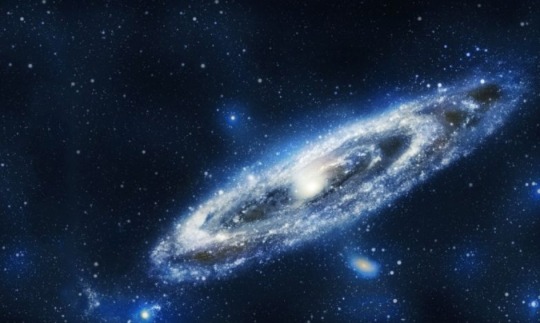
The results are from survey of the same patch of sky known as the Ultra Deep Field (UDF). This survey, called UDF12, used Hubble's Wide Field Camera 3 to peer deeper into space in near-infrared light than any previous Hubble observation.
Why infrared? Because the Universe is expanding; therefore the farther back we look, the faster objects are moving away from us, which shifts their light towards the red. Redshift means that light that is emitted as ultraviolet or visible light is shifted more and more to redder wavelengths.

The extreme distance of these newly discovered galaxies means their light has been traveling to us for more than 13 billion years, from a time when the Universe was less than 4% of its current age.
Their discovery, which you can read more about in the NASA feature is exciting because it might give us an idea of how abundant galaxies were close to the era when astronomers think galaxies first started forming. (Phil Plait has a good column about this discovery too.)
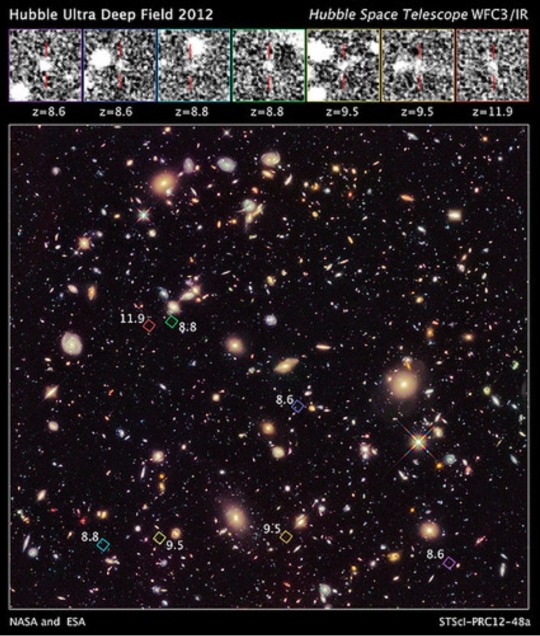
As of this writing it seems that one of the galaxies in this recent Hubble discovery may be a distance record breaker - it was observed 380 million years after the Big Bang, with a redshift of 11.9. This means the light from this galaxy (pictured below) left 13.3+ billion light years ago.
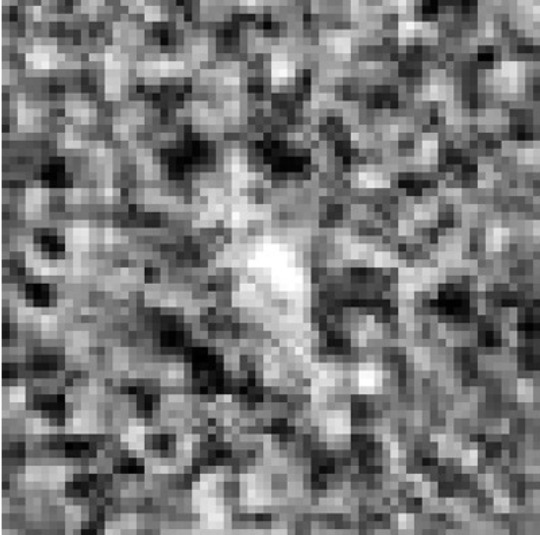
Just under a month ago, the current candidate was this object: a young galaxy called MACS0647-JD. It's only a tiny fraction of the size of our Milky Way - and was observed at 420 million years after the Big Bang, when the universe was 3 percent of its present age of 13.7 billion years. To spot this galaxy, astronomers used the powerful gravity from the massive galaxy cluster MACS J0647+7015 to magnify the light from the distant galaxy; this effect is called gravitational lensing
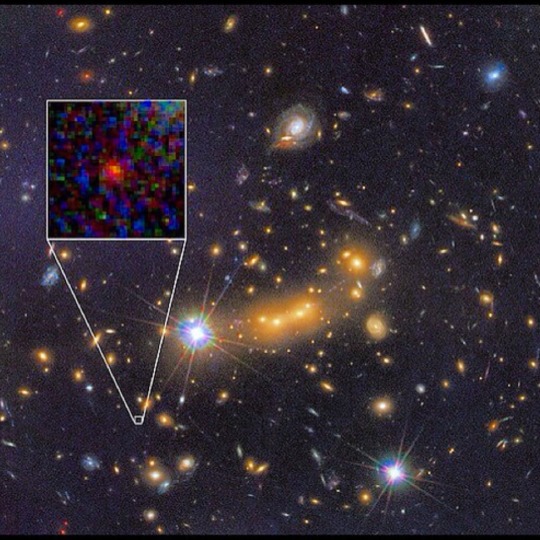
Originally published on imagine.gsfc.nasa.gov
COMING UP!!
(Wednesday, November 15th, 2023)
"WHERE DID WATER COME FROM ON EARTH??"
#astronomy#outer space#alternate universe#astrophysics#universe#spacecraft#white universe#space#parallel universe#astrophotography
89 notes
·
View notes
Note
TRICK OR TREAT!! 👻 🎃
ahhh i can’t believe i missed this one!

you get the hubble deep field image!
13 notes
·
View notes
Text
Abell 370 Parallel Field with Asteroids
Some asteroids from within our Solar System have photobombed deep images of the Universe taken by the NASA/ESA Hubble Space Telescope. These asteroids reside, on average, only about 260 million kilometres from Earth — right around the corner in astronomical terms. Yet they've horned their way into this picture of thousands of galaxies scattered across space and time at inconceivably farther distances. This Hubble photo of a random patch of sky is part of the Frontier Fields survey. The colourful image contains thousands of galaxies, including massive yellowish ellipticals and majestic blue spirals. Much smaller, fragmentary blue galaxies are sprinkled throughout the field. The reddest objects are most likely the farthest galaxies, whose light has been stretched into the red part of the spectrum by the expansion of space. Intruding across the picture are asteroid trails that appear as curved or S-shaped streaks. Rather than leaving one long trail, the asteroids appear in multiple Hubble exposures that have been combined into one image. Of the 20 total asteroid sightings for this field, seven are unique objects. Of these seven asteroids, only two were earlier identified. The others were too faint to be seen previously. The trails look curved due to an observational effect called parallax. As Hubble orbits around Earth, an asteroid will appear to move along an arc with respect to the vastly more distant background stars and galaxies. The motion of Earth around the Sun, and the motion of the asteroids along their orbits, are other contributing factors to the apparent skewing of asteroid paths.
All the asteroids were found manually, the majority by "blinking" consecutive exposures to capture apparent asteroid motion. Astronomers found a unique asteroid for every 10 to 20 hours of exposure time.
Top 5 famous space photography of all time
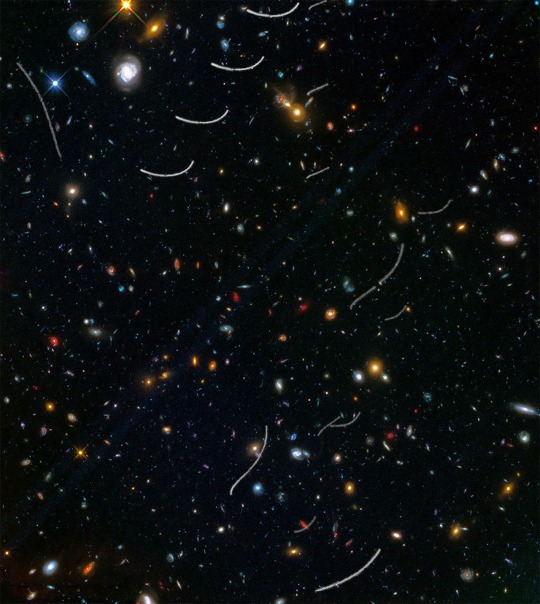
#astronomy#nasa#astronomers#universe#nasa photos#astrophotography#astrophysics#outer space#nasawebb#hubble space telescope#space exploration#space#nasa science#science facts#planetary science#space science#planetary nebula#galaxies#galaxy#nebula#our universe#i love astronomy#astronomy facts#astronauts#astronaut#nasa picture of the day#nasaastronaut#nasa jpl#asteroid observations#asteroids
25 notes
·
View notes